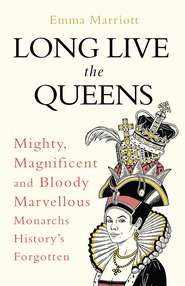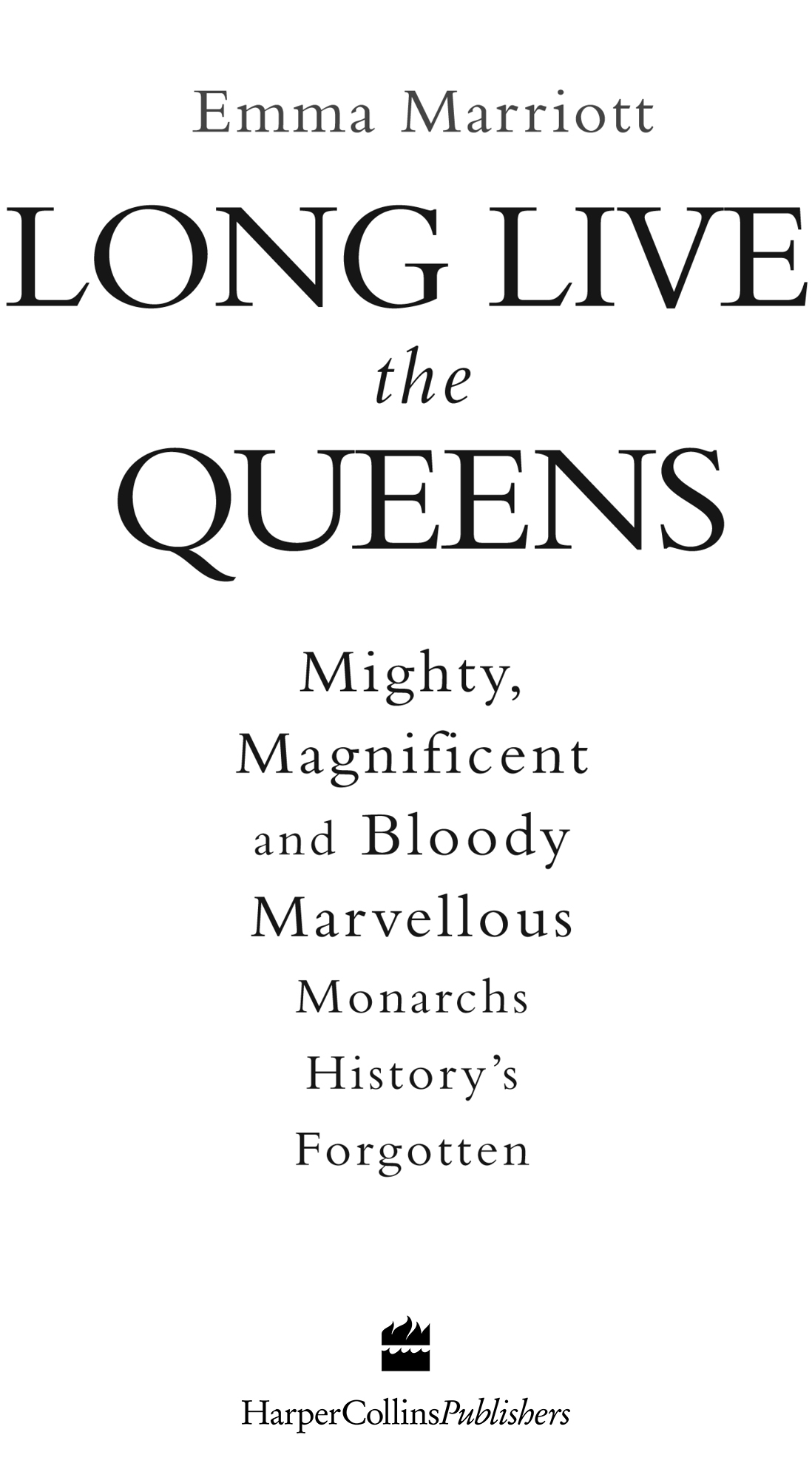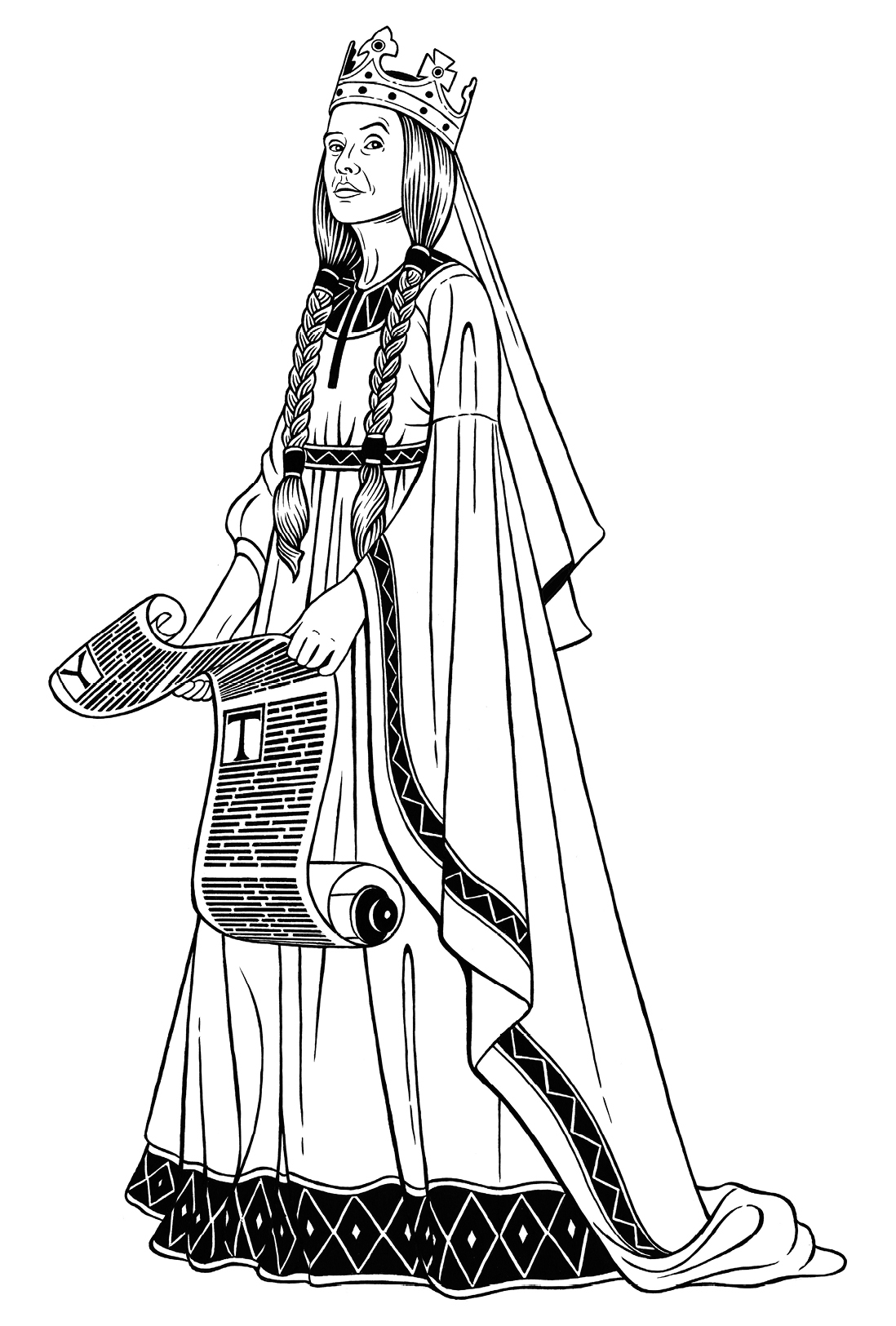
Полная версия:
Long Live the Queens: Mighty, Magnificent and Bloody Marvellous Monarchs History’s Forgotten


Copyright
HarperCollinsPublishers
1 London Bridge Street
London SE1 9GF
www.harpercollins.co.uk
First published by HarperCollinsPublishers 2019
FIRST EDITION
Text © Emma Marriott 2019
Illustrations © Stuart Patience 2019
Cover layout design by Andrew Davis © HarperCollinsPublishers 2019
Cover illustrations © Stuart Patience 2019
A catalogue record of this book is available from the British Library
Emma Marriott asserts the moral right to be identified as the author of this work
All rights reserved under International and Pan-American Copyright Conventions. By payment of the required fees, you have been granted the nonexclusive, non-transferable right to access and read the text of this e-book on screen. No part of this text may be reproduced, transmitted, downloaded, decompiled, reverse engineered, or stored in or introduced into any information storage retrieval system, in any form or by any means, whether electronic or mechanical, now known or hereinafter invented, without the express written permission of HarperCollins e-books.
Find out about HarperCollins and the environment at
www.harpercollins.co.uk/green
Source ISBN: 9780008355524
Ebook Edition © October 2019 ISBN: 9780008355531
Version: 2019-09-12
Note to Readers
This ebook contains the following accessibility features which, if supported by your device, can be accessed via your ereader/accessibility settings:
Change of font size and line height
Change of background and font colours
Change of font
Change justification
Text to speech
Page numbers taken from the following print edition: ISBN 9780008355524
Contents
1 Cover
2 Title Page
3 Copyright
4 Note to Readers
5 Contents
6 Introduction
7 TRAILBLAZERS
8 Matilda of Flanders
9 Wu Zetian
10 Margaret Tudor
11 Arwa al-Sulayhi
12 Seondeok of Silla
13 Tamar of Georgia
14 FREE-THINKERS
15 Henrietta Maria of France
16 Queen Nzinga
17 Elisabeth of Austria
18 Empress Theodora
19 Caroline of Brunswick
20 Sayyida al-Hurra
21 WARRIORS
22 Boudica
23 Eleanor of Provence
24 Trung Trac
25 Queen Amina
26 Yaa Asantewaa
27 REBELS
28 Lakshmibai, Rani of Jhansi
29 Zenobia
30 Queen Ranavalona I of Madagascar
31 Christina of Sweden
32 Anacaona
33 Joanna of Castile
34 Queen Liliuokalani
35 SURVIVORS
36 Katherine Parr
37 Margaret of Anjou
38 Cartimandua
39 Marie Leszczyńska
40 Catherine of Aragon
41 Queen Anne
42 IMAGE-MAKERS
43 Elizabeth I of Russia
44 Empress Irene of Athens
45 Hatshepsut
46 Sammu-ramat
47 Cynethryth
48 GUIDING LIGHTS
49 Adelaide of Saxe-Meiningen
50 Margaret Drummond
51 Nur Jahan
52 Queen Elfrida
53 Emma of Normandy
54 Acknowledgements
55 Bibliography
56 About the Publisher
LandmarksCoverFrontmatterStart of ContentBackmatter
List of Pagesiiiiv1357891011121314151617181920212223252627282931323334353637383940414345464748495051525354555758596061626364656667686970717273747576777879818384858687888990919293949596979899101102103104105106107108109111113114115116117118119120121122123124125126127128129131132133134135136137138139140141143144145146147148149150151152153155157158159160161162163164165166167168169170171172173175176177178179180181182183184185186187188189190191193195196197198199200201202203204205207208209210211213214215216217219220221222223225227228229230231232233234235236237239240241242243244245246247248249251252253254255256257259261262263264
Introduction
Throughout history, queens have wielded significant power and influence, and yet surprisingly few have received the kind of attention or fame they deserve. This book shines a light on these lesser-known sovereigns, many of whom proved themselves as shrewd politicians, able administrators or mighty commanders of armies, whilst others were as flawed or as brutal as their male counterparts.
Here are queens who have been long forgotten, overlooked, unfairly maligned or simply dismissed as mere bit-players on the world stage. Some ruled as queens in their own right whilst others were crowned queen consorts to kings. Many ruled on behalf of young heirs, fiercely protecting their offspring’s right to succeed, whilst others took over the reins of power when their kings were away for months, if not years. And some queens were forced to usurp power from inept husbands, when it was clear they had strength of character and were far better equipped to rule.
Not that ruling as Queen was all that easy: top of the tick-list of requirements for many queens was to produce the all-important heir to the throne (and preferably a couple of spares). Queens were also expected to be the model of subservience and virtue, no matter how badly their husbands behaved, whilst also acting as the ‘human face’ of the crown, giving alms to the poor, patronising religious institutions, smoothing over family and dynastic disputes and sponsoring artistic and literary endeavours.
Fulfilling all the expectations for a queen was indeed a tricky balancing act, for which they have always been harshly judged. Toe the line, produce a batch of sons, behave modestly and smile nicely at court and history may well forget you. Fail to produce an heir and you might be replaced or despatched (the nasty way). Refuse to submit to your husband or rail against his infidelities and you’ll be judged wilful or even mad. And should you wield power and maybe punish your rivals as men have done for centuries, then chances are you’ll be labelled as an evil tyrant/monster (but, then again, at least you might not be entirely forgotten …)
The queens covered in this book may have been cast into the shadows in some way, but they all have extraordinary stories to tell. Some, like Boudica, were once entirely forgotten, only to surface centuries later. Many queens are famous in their homelands but decidedly not famous elsewhere in the world; some names might trigger a twitch of recognition but many would draw a blank. There have also been deliberate attempts in the past to wipe some queens from memory, almost as if they were seen as an embarrassment, an anomaly best forgotten in the male-to-male succession. (Thankfully, archaeologists have unearthed the truth about the likes of ancient Egypt’s Hatshepsut, but are there other queens we know nothing about?) There are also those queens who have been defined largely by the exploits of their husbands (Catherine of Aragon and Katherine Parr step forward) or have made handy ‘withered hags’ in works of fiction (cue Margaret of Anjou) but whose portrayals bear little reality to their actual lives.
Forgotten, glossed over or much maligned, the queens in this book lived from as long as ago as 1500 BCE right up to the early twentieth century, and cover the globe from Europe to Africa, the Americas and the Middle East. They are grouped into seven chapters, loosely defined by their style of rule or deeds. The queens represented as trailblazers mark some of the sovereigns who were the first of a kind, whose reigns marked a zenith of a particular empire or set in motion a later momentous event. History is awash with free-thinking queens, those who were led by their own convictions and ideas regardless of what was expected of them. The warrior queens are an impressive group, although history tends to treat them with either awe or disgust, a surprising number of them supposedly having voracious sexual appetites or bumping off their lovers before the bedsheets were even cold.
Some female rulers, deemed ‘rebels’ in this book, fought against mighty and rapacious empires, controlling husbands or the restrictions placed on them as queens. Other rulers did well to survive, as being a queen is not necessarily an easy ride. Girls from noble families, bred to be dynastic pawns, were sent off to strange lands at ridiculously young ages, often to marry much older men before suffering pregnancy after pregnancy, the death of infants, perilous court factions, and a less-than-welcoming attitude by many men to women having so much as an ounce of power. To survive all of that and then actually achieve something – well, that definitely is worth remembering. A sixth sense seems almost to have told some queens that they needed to make their mark, stamping their authority as image-makers on coins, on statues and in monumental structures that some male successors even attempted to pass off as their own. The guiding lights of this world are queens who provided wise counsel to their husbands or subjects, or who defined the role of queenship for others to follow in their stead.
They’re all here – fearsome elephant-riding warrior queens, ruthless trailblazers, cross-dressing rebels, lusty free-thinkers, tough-as-boots survivors and enlightened guiding lights. It’s time to find out just how mighty, magnificent and bloody marvellous these forgotten queens really were.


Matilda of Flanders

Born: circa 1031
Died: 1083
William the Conqueror, who in 1066 defeated King Harold at the Battle of Hastings during the Norman Conquest of England, remains a legendary figure. But what of his queen? Who is aware of the considerable role she played in supporting and facilitating the invasion, or that she was the first Queen of England to be crowned separately in Westminster Abbey? How many could even recall her name?
William’s queen was, unsurprisingly, better known in France, in particular the region of Normandy, where she and William ruled as Duke and Duchess. Raised in the powerful medieval principality of Flanders, Matilda was of noble birth, grand-daughter of a king of France (King Robert II, who died in 1031) and descendant of the Frankish emperor, Charlemagne, and the Saxon king, Alfred the Great. William had impressive lineage through his father, Robert I, Duke of Normandy, but his mother was the unmarried Herleva of Falaise, a lowly tanner’s daughter. Although William would later defiantly sign his name ‘William Bastard’, he could never quite shake off the taint of bastardy and would react violently if taunted.
Legends tell of Matilda first refusing William’s offer of marriage on account of his illegitimacy, publicly declaring to the Duke’s envoys and her father Count Baldwin that ‘she would not have a bastard for a husband’. Her father had hoped for a closer alliance with the ruler of Normandy, but he was forced to turn William down (a rare occurrence when high-born women were generally forced into arranged marriages). Tales then tell of a furious William riding to Bruges, dragging Matilda off her horse by her long braids and throwing her into the mud. Count Baldwin was rightly outraged, although Matilda is said to have enjoyed this display of raw machismo, deciding then that William was the man for her. The story smacks of male fantasy and indeed formed part of a scurrilous volume full of anti-Norman sentiment penned by monks two centuries after the event – hardly a reliable source on which to draw an accurate picture of a Norman ruler, never mind a female one. It is just as likely that her change of heart was brought about by having been turned down herself by a former suitor, the Saxon leader Brictric, for reasons unknown.
Whatever the cause, the marriage went ahead in 1050, in defiance of Pope Leo IX, who initially forbade the match partly on the grounds that the couple were distantly related. Matilda was at most nineteen and William twenty-three. By all accounts the marriage was harmonious from the outset, with a papal dispensation later awarded by Pope Nicholas II. It was said that Matilda ‘united beauty and gentle breeding with all the graces of Christian holiness’ – attributes typically expected of noble women of the period.
As wife to William, Matilda fulfilled her principle duty of procreation, bearing ten children who survived into adulthood, including the two future English kings, William II and Henry I. Although their marriage was a strategic alliance, it seems to have been one of genuine love and trust and, unusually for a medieval ruler, William was not known to have had any mistresses or to have fathered any illegitimate children. It also proved to be an effective ruling partnership: Matilda witnessed countless charters and presided with William in court when he heard lawsuits, and they both founded and sponsored churches and religious institutions across the duchy.
With such a capable ally at his side, William was able to turn his attention to further horizons, namely that of the Crown of England which, he maintained, Edward the Confessor had promised him. As he built his immense fleet in preparation for invasion, Matilda secretly outfitted a ship, the Mora, and stood at its prow as it sailed into harbour. So astonished and thrilled was William that he used it as his flagship (as shown in the Bayeux Tapestry – an embroidered cloth depicting events leading up to the Norman Conquest of England). Before leaving for England, William solemnly invested Matilda with the regency of Normandy, safeguarding to her the protection of the duchy in the name of their fifteen-year-old eldest son, Robert.
These were turbulent times in Normandy and William’s absence could well have prompted others to try to seize control of the French duchy. Despite this, there were no major uprisings or rebellions during William’s leave and it was said that Matilda presided over the court and government with great prudence and skill, William of Poitiers conceding the ‘government was carried on smoothly’ by a woman of ‘masculine wisdom’ (‘feminine wisdom’ being deemed pretty much non-existent back then).
Across the Channel, William had by Christmas Day 1066 secured the crown of England, although it was over a year before Matilda would visit his new realm. At around Easter of 1068, she landed at Dover, where she was met by her king and a company of nobles. They escorted her to the palace of Westminster and on 11 May she was anointed with holy oil and adorned with a crown, ring and sceptre at an elaborate ceremony at Westminster Abbey. In England, queen consorts had been crowned with their kings since 973, but Matilda was the first to have a separate coronation, in a revised service which proclaimed that she shared royal power with the King, almost as if she were a queen regnant. It was a coronation that, unlike any service before, boosted her power and prestige as queen and secured that of her successors.
With such holy honours bestowed on Matilda, she would have been aware of her weighty responsibilities as Queen. As wife to the King, she was expected to support and love her husband, produce healthy heirs, and embody the virtues of piety and virtue by patronising religious institutions and giving to charity. As England’s queen, her gifts to religious houses are well documented – ‘while the victorious arms of her illustrious spouse subdued all things before him, she was indefatigable at alleviating distress in every shape, and redoubled her alms’. Matilda was also a great patron of painters, architects and poets in England, bringing Flemish artisans to the country and employing English seamstresses who were famed for their skills. (It was once wrongly thought she commissioned the Bayeux Tapestry, on which she makes no appearance.)
As a medieval queen, her role was also a political one, requiring her to foster good relations at court, whilst also mediate and smooth over family and dynastic disputes. As in Normandy, Matilda gave judgements and heard pleas jointly with William in English courts and he gave her the authority to hear lawsuits over land disputes, as mentioned several times in the Domesday Book. She witnessed many royal charters, some jointly with William, her name appearing below his but above their sons (although, as neither could write, they marked their names with a symbol, she with a Jerusalem cross).
As William battled to consolidate his rule in England, particularly in the troublesome north of the country, it was said that a heavily pregnant Matilda travelled some 200 miles to be with her husband and that their fourth child Henry was born just south of York in late 1068. The subsequent year saw further resistance in the north, culminating in William ordering a violent annihilation of entire villages and the burning of crops and herds. During this tumultuous time, he sent Matilda back to Normandy, where she again ruled in William’s stead, bringing up their children, issuing charters and attending Councils of State. In England, William continued to establish his rule, bestowing land and titles to Norman barons and encouraging them to raise fortified castles across the kingdom. By 1072, the conquest was more or less complete, largely at the expense of the Saxon population, who were savagely oppressed by the new Norman aristocracy.
In 1074, Matilda was briefly again made Queen Regent of Normandy, the same year that she and William lost their second son, Richard, in a hunting accident. In 1076, trouble flared between William and their eldest son, Robert, on whom Matilda doted but who proved a disappointment to his father, his short stature, ‘pot belly’ and fat legs earning him the unflattering moniker of Robert ‘Curthose’. Officially, Robert was Duke of Normandy, but he was frustrated by his father not granting him full autonomy, a resentment that broke out into open hostilities in 1078 as the King fought a three-week siege against Robert, during which father and son actually fought, with the King’s horse killed and his hand wounded. Not unsurprisingly, the feud greatly distressed Matilda, and it was soon discovered that she had been secretly sending Robert large sums of money, much to the fury of William. When he confronted Matilda, she stood her ground, pleading maternal devotion, for which William eventually forgave her: father and son were formally reconciled in 1080.
By the early 1080s, Matilda’s health was beginning to suffer and she died in November 1083, around the age of fifty-two. After thirty-three years of marriage, William was apparently inconsolable, some saying from thereon ‘he abandoned pleasure of every kind.’ Matilda was buried at the convent of the Holy Trinity at Caen. Her passing was mourned throughout France, and it was claimed she was ‘wept for by the English and the Normans for many years’. She had proved herself a most able ruler, one who wielded great power and influence in Normandy and England, who was by turns an ambitious consort, a wise counsel, a capable leader and doting mother – a queen who deserves much greater acclaim, for being both a powerful ally to William the Conqueror and ruler in her own right.

Wu Zetian

Born: 624 CE
Died: 705 CE
Some fifty miles northwest of the modern Chinese city of Xi’an, deep within Mount Liang, is the tomb of Empress Wu Zetian. There lies the remains of an Empress of China who ruled for more than fifty years during the Tang dynasty (610–907 CE), the only woman in 3,000 years of Chinese history to have sat on the Chinese throne as ruler in her own right.
And yet the great memorial tablet that stands at the entrance to her tomb, erected during her lifetime so that her successors could compose the usual epitaph proclaiming her worthiness as empress, remains starkly blank. By contrast, the tablet that immortalises her husband, Emperor Gaozong, buried in the same mausoleum, carries the usual inscription recording his deeds as emperor, as composed by Wu Zetian to a husband whose death preceded hers by some twenty years.
The lack of inscription on Wu’s memorial, the only one of its kind, was clearly an attempt to obscure any record of Wu Zetian’s rule; she died and lies near to her husband but any other details are best forgotten. The omission also reflects how she was perceived by people around her and successors – in particular the Confucian hierarchy who deeply disapproved of her and the idea of any women having genuine power, deemed as unnatural as having a ‘hen crow like a rooster at daybreak’.
Despite attempts to remove her from record, Wu Zetian is now an immensely famous figure in China – the subject of books, films and TV shows – although she is still largely unknown in the West. Much of her fame, however, rests on her startling propensity for ruthlessness: murdering female rivals, elder statesmen who opposed her, and even members of her own family so that she could wield supreme power. Her image is that of a murderous megalomaniac, almost as if a warning of what a woman can do when given enough power, an image that has in the past overshadowed the many achievements of her reign.
Born in 624 CE, Wu Zetian (original name Wu Zhao) entered the palace of the Tang emperor Taizong in 638 as a fourteen-year-old concubine. As the daughter of a minor general, this was deemed quite an honour, although her role at first would largely be as a glorified serving woman. Little is known about her life as a concubine but it’s thought she managed to get close to the Emperor when her duties included changing the imperial bed sheets. When the Emperor died in 649, the custom was for concubines to have their heads shaved and be sent to a convent, where they would remain for the rest of their lives. Taizong’s heir, Gaozong, however, brought Wu back to the palace as his favourite concubine, her rise in status brought about, as some Chinese historians have speculated, by her willingness to gratify emperors’ unusual sexual appetites.
Having given birth to two sons, Wu had a daughter in 654 who died soon after. Wu accused the wife of Gaozong, Empress Wang, of strangling the child in a fit of a jealousy over her own childlessness, although other histories of the period claim Wu smothered the child herself only then to blame the Empress for the death. Wang was subsequently demoted and imprisoned along with another leading concubine. It is said that Wu, who had now replaced Wang as Empress Consort, ordered that both women have their legs and arms cut off and their torsos thrown into a vat of wine, leaving them to drown – an account suspiciously similar to the revenge act of a previous empress, Lu Zhi (241–180 BCE), who is held up in Chinese history as one of the most wicked female rulers.



